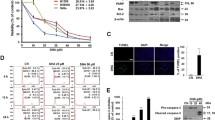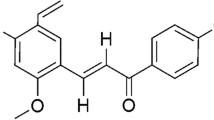Abstract
Thymoquinone (TQ), a component of black seed essential oil, is known to induce apoptotic cell death and oxidative stress, however, the direct involvement of oxidants in TQ-induced cell death has not been established yet. Here, we show that TQ inhibited the proliferation of a panel of human colon cancer cells (Caco-2, HCT-116, LoVo, DLD-1 and HT-29), without exhibiting cytotoxicity to normal human intestinal FHs74Int cells. Further investigation in DLD-1 revealed that apoptotic cell death is the mechanism for TQ-induced growth inhibition as confirmed by flow cytometry, M30 cytodeath and caspase-3/7 activation. Apoptosis was induced via the generation of reactive oxygen species (ROS) as evidenced by the abrogation of TQ apoptotic effect in cells preincubated with the strong antioxidant N-acetyl cysteine (NAC). TQ increased the phosphorylation states of the mitogen-activated protein kinases (MAPK) JNK and ERK, but not of p38. Their activation was completely abolished in the presence of NAC. Using PD98059 and SP600125, specific ERK and JNK inhibitors, the two kinases were found to possess pro-survival activities in TQ-induced cell death. These data present evidence linking the pro-oxidant effects of TQ with its apoptotic effects in colon cancer and prove a protective role of MAPK.







Similar content being viewed by others
References
Ali BH, Blunden G (2003) Pharmacological and toxicological properties of Nigella sativa. Phytother Res 17:299–305. doi:10.1002/ptr.1309
Marsik P, Kokoska L, Landa P, Nepovim A, Soudek P, Vanek T (2005) In vitro inhibitory effects of thymol and quinones of Nigella sativa seeds on cyclooxygenase-1- and -2-catalyzed prostaglandin E2 biosyntheses. Planta Med 71:739–742. doi:10.1055/s-2005-871288
Norwood AA, Tan M, May M, Tucci M, Benghuzzi H (2006) Comparison of potential chemotherapeutic agents, 5-fluoruracil, green tea, and thymoquinone on colon cancer cells. Biomed Sci Instrum 42:350–356
Gali-Muhtasib H, Kuester D, Mawrin C et al (2008) Thymoquinone triggers inactivation of the stress response pathway sensor CHEK1 and contributes to apoptosis in colorectal cancer cells. Cancer Res 68:5609–5618. doi:10.1158/0008-5472.CAN-08-0884
Gali-Muhtasib H, Ocker M, Kuester D et al (2008) Thymoquinone reduces mouse colon tumor cell invasion and inhibits tumor growth in murine colon cancer models. J Cell Mol Med 12:330–342. doi:10.1111/j.1582-4934.2007.00095.x
El-Mahdy MA, Zhu Q, Wang QE, Wani G, Wani AA (2005) Thymoquinone induces apoptosis through activation of caspase-8 and mitochondrial events in p53-null myeloblastic leukemia HL-60 cells. Int J Cancer 117:409–417. doi:10.1002/ijc.21205
Womack K, Anderson M, Tucci M, Hamadain E, Benghuzzi H (2006) Evaluation of bioflavonoids as potential chemotherapeutic agents. Biomed Sci Instrum 42:464–469
Richards LR, Jones P, Hughes J, Benghuzzi H, Tucci M (2006) The physiological effect of conventional treatment with epigallocatechin-3-gallate, thymoquinone, and tannic acid on the LNCaP cell line. Biomed Sci Instrum 42:357–362
Tan M, Norwood A, May M, Tucci M, Benghuzzi H (2006) Effects of (-)epigallocatechin gallate and thymoquinone on proliferation of a PANC-1 cell line in culture. Biomed Sci Instrum 42:363–371
Rooney S, Ryan MF (2005) Modes of action of alpha-hederin and thymoquinone, active constituents of Nigella sativa, against HEp-2 cancer cells. Anticancer Res 25:4255–4259
Martin TM, Benghuzzi H, Tucci M (2006) The effect of conventional and sustained delivery of thymoquinone and levodopa on SH-SY5Y human neuroblastoma cells. Biomed Sci Instrum 42:332–337
Tekeoglu I, Dogan A, Demiralp L (2006) Effects of thymoquinone (volatile oil of black cumin) on rheumatoid arthritis in rat models. Phytother Res 20:869–871. doi:10.1002/ptr.1964
El Gazzar M, El Mezayen R, Marecki JC, Nicolls MR, Canastar A, Dreskin SC (2006) Anti-inflammatory effect of thymoquinone in a mouse model of allergic lung inflammation. Int Immunopharmacol 6:1135–1142. doi:10.1016/j.intimp.2006.02.004
El Mezayen R, El Gazzar M, Nicolls MR, Marecki JC, Dreskin SC, Nomiyama H (2006) Effect of thymoquinone on cyclooxygenase expression and prostaglandin production in a mouse model of allergic airway inflammation. Immunol Lett 106:72–81. doi:10.1016/j.imlet.2006.04.012
El Gazzar MA, El Mezayen R, Nicolls MR, Dreskin SC (2007) Thymoquinone attenuates proinflammatory responses in lipopolysaccharide-activated mast cells by modulating NF-kappaB nuclear transactivation. Biochim Biophys Acta 1770:556–564. doi:10.1016/j.bbagen.2007.01.002
Gali-Muhtasib H, Diab-Assaf M, Boltze C et al (2004) Thymoquinone extracted from black seed triggers apoptotic cell death in human colorectal cancer cells via a p53-dependent mechanism. Int J Oncol 25:857–866
Roepke M, Diestel A, Bajbouj K et al (2007) Lack of p53 augments thymoquinone-induced apoptosis and caspase activation in human osteosarcoma cells. Cancer Biol Ther 6:160–169
Nagi MN, Mansour MA (2000) Protective effect of thymoquinone against doxorubicin-induced cardiotoxicity in rats: a possible mechanism of protection. Pharmacol Res 41:283–289. doi:10.1006/phrs.1999.0585
Badary OA, Taha RA, Gamal el-Din AM, Abdel-Wahab MH (2003) Thymoquinone is a potent superoxide anion scavenger. Drug Chem Toxicol 26:87–98
Mansour MA, Nagi MN, El-Khatib AS, Al-Bekairi AM (2002) Effects of thymoquinone on antioxidant enzyme activities, lipid peroxidation and DT-diaphorase in different tissues of mice: a possible mechanism of action. Cell Biochem Funct 20:143–151. doi:10.1002/cbf.968
Lin YT, Yang JS, Lin SY et al (2008) Diallyl disulfide (DADS) induces apoptosis in human cervical cancer Ca Ski cells via reactive oxygen species and Ca2+-dependent mitochondria-dependent pathway. Anticancer Res 28:2791–2799
Zhang R, Humphreys I, Sahu RP, Shi Y, Srivastava SK (2008) In vitro and in vivo induction of apoptosis by capsaicin in pancreatic cancer cells is mediated through ROS generation and mitochondrial death pathway. Apoptosis 13:1465–1478. doi:10.1007/s10495-008-0278-6
Qian X, Li J, Ding J, Wang Z, Duan L, Hu G (2008) Glibenclamide exerts an antitumor activity through reactive oxygen species-c-jun NH2-terminal kinase pathway in human gastric cancer cell line MGC-803. Biochem Pharmacol 76:1705–1715. doi:10.1016/j.bcp.2008.09.009
Xiao D, Powolny AA, Singh SV (2008) Benzyl isothiocyanate targets mitochondrial respiratory chain to trigger reactive oxygen species-dependent apoptosis in human breast cancer cells. J Biol Chem 283:30151–30163. doi:10.1074/jbc.M802529200
Pan MH, Gao JH, Lai CS et al (2008) Antitumor activity of 3,5,4′-trimethoxystilbene in COLO 205 cells and xenografts in SCID mice. Mol Carcinog 47:184–196. doi:10.1002/mc.20352
Feng R, Ni HM, Wang SY et al (2007) Cyanidin-3-rutinoside, a natural polyphenol antioxidant, selectively kills leukemic cells by induction of oxidative stress. J Biol Chem 282:13468–13476. doi:10.1074/jbc.M610616200
Navarro R, Busnadiego I, Ruiz-Larrea MB, Ruiz-Sanz JI (2006) Superoxide anions are involved in doxorubicin-induced ERK activation in hepatocyte cultures. Ann NY Acad Sci 1090:419–428. doi:10.1196/annals.1378.045
Matsuzawa A, Ichijo H (2005) Stress-responsive protein kinases in redox-regulated apoptosis signaling. Antioxid Redox Signal 7:472–481. doi:10.1089/ars.2005.7.472
Kyosseva SV (2004) Mitogen-activated protein kinase signaling. Int Rev Neurobiol 59:201–220. doi:10.1016/S0074-7742(04)59008-6
Ku BM, Lee YK, Jeong JY et al (2007) Ethanol-induced oxidative stress is mediated by p38 MAPK pathway in mouse hippocampal cells. Neurosci Lett 419:64–67. doi:10.1016/j.neulet.2007.03.049
Wang X, Martindale JL, Liu Y, Holbrook NJ (1998) The cellular response to oxidative stress: influences of mitogen-activated protein kinase signalling pathways on cell survival. Biochem J 333(Pt 2):291–300
Benhar M, Dalyot I, Engelberg D, Levitzki A (2001) Enhanced ROS production in oncogenically transformed cells potentiates c-Jun N-terminal kinase and p38 mitogen-activated protein kinase activation and sensitization to genotoxic stress. Mol Cell Biol 21:6913–6926. doi:10.1128/MCB.21.20.6913-6926.2001
Owuor ED, Kong AN (2002) Antioxidants and oxidants regulated signal transduction pathways. Biochem Pharmacol 64:765–770
Khalife KH, Lupidi G (2008) Reduction of hypervalent states of myoglobin and hemoglobin to their ferrous forms by thymoquinone: the role of GSH, NADH and NADPH. Biochim Biophys Acta 1780:627–637. doi:10.1016/j.bbagen.2007.12.006
Karczewski JM, Peters JG, Noordhoek J (1999) Quinone toxicity in DT-diaphorase-efficient and -deficient colon carcinoma cell lines. Biochem Pharmacol 57:27–37
Cullen JJ, Hinkhouse MM, Grady M et al (2003) Dicumarol inhibition of NADPH: quinone oxidoreductase induces growth inhibition of pancreatic cancer via a superoxide-mediated mechanism. Cancer Res 63:5513–5520
Martindale JL, Holbrook NJ (2002) Cellular response to oxidative stress: signaling for suicide and survival. J Cell Physiol 192:1–15. doi:10.1002/jcp.10119
Asche C (2005) Antitumour quinones. Mini Rev Med Chem 5:449–467
Brewer J, Benghuzzi H, Tucci M (2006) Effects of thymoquinone, lycopene, and selenomethione in the presence of estrogen on the viability of SiHa cells in vitro. Biomed Sci Instrum 42:37–41
Brenner B, Koppenhoefer U, Weinstock C, Linderkamp O, Lang F, Gulbins E (1997) Fas- or ceramide-induced apoptosis is mediated by a Rac1-regulated activation of Jun N-terminal kinase/p38 kinases and GADD153. J Biol Chem 272:22173–22181
Guyton KZ, Gorospe M, Kensler TW, Holbrook NJ (1996) Mitogen-activated protein kinase (MAPK) activation by butylated hydroxytoluene hydroperoxide: implications for cellular survival and tumor promotion. Cancer Res 56:3480–3485
Ikeyama S, Kokkonen G, Shack S, Wang XT, Holbrook NJ (2002) Loss in oxidative stress tolerance with aging linked to reduced extracellular signal-regulated kinase and Akt kinase activities. FASEB J 16:114–116. doi:10.1096/fj.01-0409fje
Petrache I, Choi ME, Otterbein LE et al (1999) Mitogen-activated protein kinase pathway mediates hyperoxia-induced apoptosis in cultured macrophage cells. Am J Physiol 277:L589–L595
Wang X, Martindale JL, Holbrook NJ (2000) Requirement for ERK activation in cisplatin-induced apoptosis. J Biol Chem 275:39435–39443. doi:10.1074/jbc.M004583200
Brand A, Gil S, Seger R, Yavin E (2001) Lipid constituents in oligodendroglial cells alter susceptibility to H2O2-induced apoptotic cell death via ERK activation. J Neurochem 76:910–918
Ishikawa Y, Kitamura M (2000) Anti-apoptotic effect of quercetin: intervention in the JNK- and ERK-mediated apoptotic pathways. Kidney Int 58:1078–1087. doi:10.1046/j.1523-1755.2000.00265.x
Yi T, Cho SG, Yi Z et al (2008) Thymoquinone inhibits tumor angiogenesis and tumor growth through suppressing AKT and extracellular signal-regulated kinase signaling pathways. Mol Cancer Ther 7:1789–1796. doi:10.1158/1535-7163.MCT-08-0124
Selimovic D, Hassan M, Haikel Y, Hengge UR (2008) Taxol-induced mitochondrial stress in melanoma cells is mediated by activation of c-Jun N-terminal kinase (JNK) and p38 pathways via uncoupling protein 2. Cell Signal 20:311–322. doi:10.1016/j.cellsig.2007.10.015
Kang YH, Lee SJ (2008) The role of p38 MAPK and JNK in arsenic trioxide-induced mitochondrial cell death in human cervical cancer cells. J Cell Physiol 217:23–33. doi:10.1002/jcp.21470
Sanchez AM, Malagarie-Cazenave S, Olea N, Vara D, Chiloeches A, Diaz-Laviada I (2007) Apoptosis induced by capsaicin in prostate PC-3 cells involves ceramide accumulation, neutral sphingomyelinase, and JNK activation. Apoptosis 12:2013–2024. doi:10.1007/s10495-007-0119-z
Engelbrecht AM, Niesler C, Page C, Lochner A (2004) p38 and JNK have distinct regulatory functions on the development of apoptosis during simulated ischaemia and reperfusion in neonatal cardiomyocytes. Basic Res Cardiol 99:338–350. doi:10.1007/s00395-004-0478-3
Dougherty CJ, Kubasiak LA, Prentice H, Andreka P, Bishopric NH, Webster KA (2002) Activation of c-Jun N-terminal kinase promotes survival of cardiac myocytes after oxidative stress. Biochem J 362:561–571
Kane RC, Farrell AT, Saber H et al (2006) Sorafenib for the treatment of advanced renal cell carcinoma. Clin Cancer Res 12:7271–7278. doi:10.1158/1078-0432.CCR-06-1249
Richly H, Schultheis B, Adamietz IA et al (2008) Combination of sorafenib and doxorubicin in patients with advanced hepatocellular carcinoma: results from a phase I extension trial. Eur J Cancer. doi:10.1016/j.ejca.2008.10.039
Mross K, Steinbild S, Baas F et al (2007) Results from an in vitro and a clinical/pharmacological phase I study with the combination irinotecan and sorafenib. Eur J Cancer 43:55–63. doi:10.1016/j.ejca.2006.08.032
Acknowledgments
We thank members of the Central Research Science Laboratory at the American University of Beirut, Lebanon for their help in using the flow cytometer and HPLC. We thank Isabel Zeitträger and Astrid Taut from Department of Medicine 1, Erlangen, Germany for their technical assistance. This work was supported by Deutsche Forschungsgemeinschaft (SCHN477/7-3, SCHN477/7-4) and by the University Research Board of the AUB and the Lebanese National Council for Scientific Research. Nahed El-Najjar was partly supported by the DAAD.
Author information
Authors and Affiliations
Corresponding author
Rights and permissions
About this article
Cite this article
El-Najjar, N., Chatila, M., Moukadem, H. et al. Reactive oxygen species mediate thymoquinone-induced apoptosis and activate ERK and JNK signaling. Apoptosis 15, 183–195 (2010). https://doi.org/10.1007/s10495-009-0421-z
Published:
Issue Date:
DOI: https://doi.org/10.1007/s10495-009-0421-z




